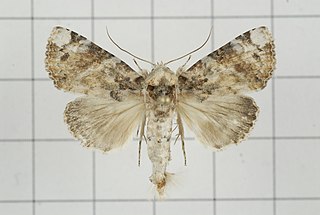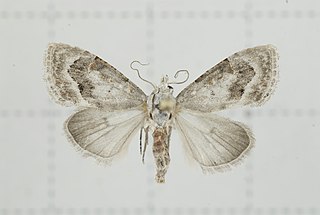Related Research Articles

Phazaca erosioides is a moth of the family Uraniidae first described by Francis Walker in 1863. It is found in the Indo-Australian tropics from Sri Lanka to New Guinea.
Giaura tortricoides is a moth of the family Nolidae first described by Francis Walker in 1865. It is found in Sri Lanka, Japan, Andaman Islands, Borneo, Sumatra, Flores, Sulawesi, New Guinea, Bismarck Islands and Australia.
Lophothripa vitea is a moth of the family Nolidae first described by Swinhoe in 1885. It is found in Indo-Australian tropics towards the Solomon Islands.

Maceda mansueta is a moth of the family Nolidae first described by Francis Walker in 1857. It is found in Japan, Sri Lanka, Borneo, India (Andamans), Malaysia, New Guinea, Fiji, Australia, Réunion and the Seychelles.
Maurilia iconica is a moth of the family Nolidae first described by Francis Walker in 1857. It is found in Indo-Australian tropics of Sri Lanka, Australia to the islands of Samoa, Rarotonga and New Caledonia.
Nycteola indicatana is a moth of the family Nolidae first described by Francis Walker in 1863. It is found in the Indian subregion, Sri Lanka, Singapore, Borneo, Java and the Solomon Islands.

Paracrama dulcissima is a moth of the family Nolidae first described by Francis Walker in 1864. It is found in Indo-Australian tropics of India, Sri Lanka and the Bismarck Islands.
Plotheia decrescens is a moth of the family Nolidae first described by Francis Walker in 1857. It is found in Sri Lanka.
Pterogonia aurigutta is a moth of the family Nolidae first described by Francis Walker in 1858. It is found in Sundaland, Singapore, Thailand, the Andaman Islands and Sri Lanka.
Etanna basalis is a moth of the family Nolidae first described by Francis Walker in 1862. It is found in Borneo, Sri Lanka, Myanmar, Thailand, New Guinea, Australia, Vanuatu and Fiji.
Lasiolopha saturata is a moth of the family Nolidae first described by Francis Walker in 1865. It is found in Oriental tropics of India, Sri Lanka, Thailand, New Guinea and Australia.
Aiteta truncata is a moth of the family Nolidae first described by Francis Walker in 1858. It is found in India and Sri Lanka.
Selepa celtis, called the hairy caterpillar as a larva, is a moth of the family Nolidae. The species was first described by Frederic Moore in 1858. It is found in Oriental tropics of India, Sri Lanka, Taiwan towards the Ryukyu Islands and Australia.
Selepa discigera is a moth of the family Nolidae first described by Francis Walker in 1864. It is found in Oriental tropics of India, Sri Lanka, New Guinea and Australia.

Earias cupreoviridis, called the cupreous bollworm as a larva, is a moth of the family Nolidae. The species was first described by Francis Walker in 1862. It is found in African countries like Botswana, the Democratic Republic of the Congo, Eritrea, Ethiopia, the Gambia, Kenya, Nigeria, Sierra Leone, South Africa, Togo, Uganda, Zimbabwe to Asian countries like India, Sri Lanka, China, Japan, Korea, Philippines, Indonesia and Hong Kong.

Beana terminigera is a moth of the family Nolidae first described by Francis Walker in 1858. It is found in India, Sri Lanka, Nepal, Thailand, Myanmar, Peninsular Malaysia, Borneo and the Philippines.
Labanda herbealis is a moth in the family Nolidae first described by Francis Walker in 1859. It is found in Sri Lanka and Borneo.
Labanda saturalis is a moth in the family Nolidae first described by Francis Walker in 1865. It is found in Indo-Australian tropics of India, Sri Lanka, and from New Guinea to the Solomon Islands.

Nola fasciata is a moth of the family Nolidae first described by Francis Walker in 1866. It is found in Indo-Australian tropics of India, Sri Lanka to Borneo, Taiwan, New Guinea and Australia.
Nola lucidalis is a moth of the family Nolidae first described by Francis Walker in 1864. It is found in the Indian subregion, Sri Lanka, Borneo, Java, the Philippines and Taiwan.
References
- ↑ "Species Details: Aquis orbicularis Walker, 1858". Catalogue of Life. Retrieved 12 November 2018.
- ↑ Koçak, Ahmet Ömer; Kemal, Muhabbet (20 February 2012). "Preliminary list of the Lepidoptera of Sri Lanka". Cesa News. Centre for Entomological Studies Ankara (79): 1–57 – via Academia.
- ↑ Savela, Markku. "Aquis orbicularis (Walker, 1858)". Lepidoptera and Some Other Life Forms. Retrieved 15 November 2018.
- ↑ "The Chloephorinae, Sarrothripini (Lepidoptera: Nolidae) of Papua Indonesia". Papua-Insects.nl. The Papua Insects Foundation. Retrieved 12 November 2018.
- ↑ ""Aquis" orbicularis Walker". The Moths of Borneo. Retrieved 12 November 2018.